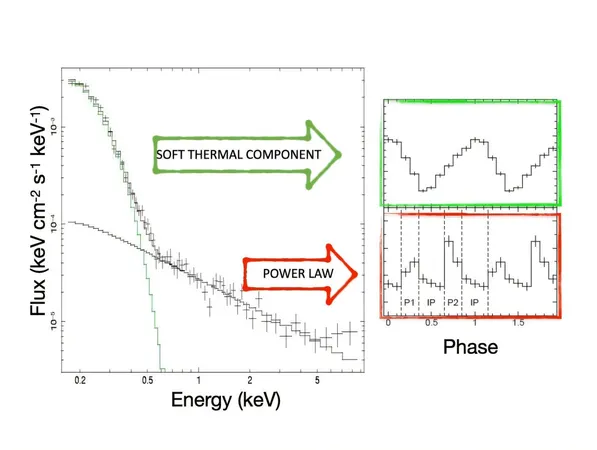
Astronomers Uncover Secrets of a Rare Binary System with a Fast-Spinning White Dwarf!
2025-01-02
Author: Wei Ling
Introduction
A thrilling new study led by Italian astronomer Sandro Mereghetti has revealed groundbreaking insights into a peculiar binary star system known as HD 49798/RX J0648.0-34418. This remarkable research, which was made available on December 24, highlights the presence of a massive and rapidly spinning white dwarf, stirring excitement among astrophysics enthusiasts and scientists alike.
About HD 49798
Situated about 1,700 light years from Earth, HD 49798 is a vibrant blue star classified as a subdwarf of O spectral type (sdO). It holds the title of the most luminous known sdO with an astounding absolute magnitude of -0.24 and an incredible bolometric luminosity that exceeds 4,400 times that of the Sun. Its effective temperature is a scorching 47,500 K, showcasing its intense energy output.
Historical Context
For decades, HD 49798 has been the focus of astronomical studies, revealing a spectrum rich in prominent helium and nitrogen lines. Observations have noted intriguing radial velocity variations, hinting at the existence of a companion star. Yet, the true nature of this companion has long remained a mystery—until now.
Recent Findings
Recent analyses have detected soft X-ray emissions emanating from the binary system, correlated with HD 49798 and demonstrating a clear periodicity. This suggests the presence of either a neutron star or a white dwarf. Mereghetti’s latest investigation has provided compelling evidence for the latter option.
Key Insights from Mereghetti
In his findings, Mereghetti asserts, “There are now several arguments indicating that the companion of HD 49798 is a massive white dwarf, with interesting implications for the future evolution of this system.”
Characteristics of the White Dwarf
Remarkably, this white dwarf has an estimated mass of 1.22 solar masses and a rapid spin period of approximately 13.2 seconds, marking it as one of the fastest-spinning white dwarfs known to date. While its mass and spin period could potentially align with neutron star traits, the analysis of its X-ray luminosity and the characteristics of the X-ray emitting region strongly suggests a white dwarf classification.
X-ray Emissions and Accretion Process
The study reveals that this white dwarf is producing pulsed X-rays, characterized by an unusually soft spectrum, fueled by material accreted from the stellar wind of its subdwarf companion—a star with a radius of around 1.08 solar radii and mass of approximately 1.41 solar masses. Intriguingly, the orbital period of the system was measured at about 1.55 days.
Significance of the Discovery
Unique among its class, HD 49798/RX J0648.0-34418 stands out as the only known accretion-powered X-ray binary where the mass donor is a hot subdwarf star. This combination of the white dwarf's substantial mass and rapid spin, paired with the luminosity and peculiar chemical makeup of the subdwarf, renders this binary system particularly distinctive when juxtaposed with similar celestial pairings.
Conclusion
Mereghetti concludes that the unparalleled attributes of HD 49798/RX J0648.0-34418 make it a subject of great interest, not just within stellar evolution models, but also in the broader exploration of hot subdwarfs and white dwarfs. This exciting discovery could pave the way for future research, deepening our understanding of stellar evolution and the intricate dynamics of binary star systems.
Call to Action
Don’t miss out on the latest cosmic revelations—subscribe for more stellar discoveries!


 Brasil (PT)
Brasil (PT)
 Canada (EN)
Canada (EN)
 Chile (ES)
Chile (ES)
 Česko (CS)
Česko (CS)
 대한민국 (KO)
대한민국 (KO)
 España (ES)
España (ES)
 France (FR)
France (FR)
 Hong Kong (EN)
Hong Kong (EN)
 Italia (IT)
Italia (IT)
 日本 (JA)
日本 (JA)
 Magyarország (HU)
Magyarország (HU)
 Norge (NO)
Norge (NO)
 Polska (PL)
Polska (PL)
 Schweiz (DE)
Schweiz (DE)
 Singapore (EN)
Singapore (EN)
 Sverige (SV)
Sverige (SV)
 Suomi (FI)
Suomi (FI)
 Türkiye (TR)
Türkiye (TR)
 الإمارات العربية المتحدة (AR)
الإمارات العربية المتحدة (AR)